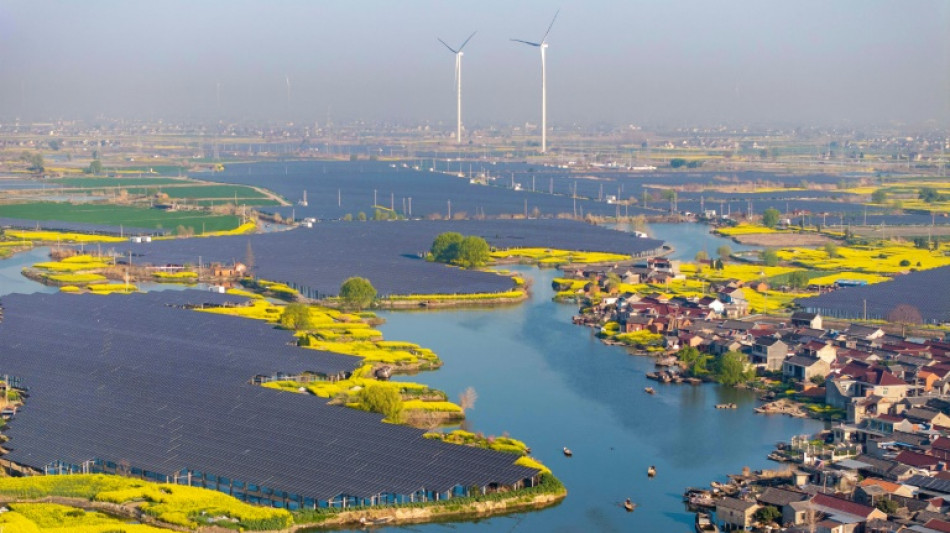
| RBGPF | -0.41% | 63.19 | $ | |
| CMSC | -0.2% | 22.285 | $ | |
| RYCEF | 2.28% | 10.07 | $ | |
| RIO | -1.84% | 60.576 | $ | |
| VOD | 0.05% | 9.315 | $ | |
| NGG | -0.24% | 72.09 | $ | |
| CMSD | -0.25% | 22.393 | $ | |
| SCS | -1.38% | 9.815 | $ | |
| GSK | -0.53% | 37.301 | $ | |
| BCC | -1.31% | 94.845 | $ | |
| RELX | 0.1% | 53.225 | $ | |
| AZN | -0.17% | 69.43 | $ | |
| BP | 0.53% | 29.155 | $ | |
| JRI | 0.55% | 12.67 | $ | |
| BCE | -2.83% | 21.405 | $ | |
| BTI | -0.98% | 42.039 | $ |

China says wind and solar energy capacity exceeds thermal for first time
China's wind and solar energy capacity has surpassed that of mostly coal-powered thermal for the first time, the national energy body said Friday.
China, the world's largest emitter of greenhouse gases that drive climate change, has pledged to peak carbon emissions by 2030 and achieve carbon neutrality by 2060.
While around 60 percent of China's energy comes from coal, the country is also a renewable energy powerhouse, building almost twice as much wind and solar capacity as every other country combined, according to research published last year.
"In the first quarter of 2025, China's newly installed wind and photovoltaic power capacity totalled 74.33 million kilowatts, bringing the cumulative installed capacity to 1.482 billion kilowatts," the national energy body said.
That surpassed the installed capacity of thermal power (1.451 billion kilowatts) for the first time.
President Xi Jinping said on Wednesday that "no matter how the international situation changes", the country's efforts to combat climate change "will not slow down".
Xi also said China would announce its 2035 greenhouse gas reduction commitments, known as Nationally Determined Contributions (NDCs), before COP30 in November and that it would cover all greenhouse gases, not just carbon dioxide.
President Donald Trump meanwhile has pulled the United States, the world's second-largest polluter, out of the Paris climate accord while pledging a vast expansion in fossil fuel exploitation.
-'Structural change'-
China's new milestone comes as the country experiences explosive growth in renewable energy.
Last year, China added a record 357 gigawatts of wind and solar, 10 times the US's additions.
It met a 2030 target to install 1,200 GW of solar and wind capacity almost six years early.
Friday's announcement said that wind and solar additions in the first quarter had "far exceeded" China's total increase in electricity consumption.
"This trend is very likely to continue in the following months and quarters in 2025," Yao Zhe, Global Policy adviser at Greenpeace East Asia, told AFP.
That suggests China's power sector is undergoing "structural change and the sector's carbon emissions are one small step away from peaking".
However, coal continues to play a key role in China's energy mix.
"The intermittency of variable renewables like wind and solar... means it's generally inappropriate to compare them to firm, dispatchable power sources like coal," according to David Fishman, senior manager at the Lantau Group.
"There is indeed some combination of wind plus solar plus storage that equals one coal plant, but the determination is different everywhere in the world."
And China's energy consumption continues to grow –- by 4.3 percent last year.
Covering that growth with renewable power is a "tough proposition for a developing country with a huge heavy industrial segment and a residential population that frankly doesn't even use that much electricity on a per capita basis", Fishman said.
Despite the renewable energy boom, China also began construction on 94.5 gigawatts of coal power projects in 2024, 93 percent of the global total, according to a February report from the Finland-based Centre for Research on Energy and Clean Air (CREA) and Global Energy Monitor (GEM) in the United States.
China's coal production has risen steadily in recent years, from 3.9 billion tons in 2020 to 4.8 billion tons in 2024.
That is despite Xi pledging to "strictly control" coal power before "phasing it down" between 2026 and 2030.
P.MacNair--NG



